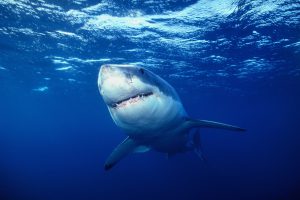As part of my Florida Sea Grant Extension work, I teach and present about elasmobranchs (which includes sharks, rays, and skates) to diverse groups of people. Topics vary, from basic biology to shark fishing regulations, conservation status, and more. I enjoy teaching about sharks and rays, since they are fascinating creatures and ecologically important.
My favorite part of my interactions with the public is the Q&A section. That’s in part because I get to answer things that perhaps I did not cover, and partly because it gives me an opportunity to clarify things or reemphasize a point. Mainly, though, I really enjoy it because the questions sometimes generate great discussions, especially when the question asked does not have a clear answer.
And this blog is about one of those questions. Specifically…
Do sharks sleep?

I have been asked this on a few occasions. Always, before I answer the question, I ask the audience: do all animals sleep? The most common responses are: “Yes, although I am not sure how,” “Of course,” and “I do not know.” This is a complex question, and there is not a simple answer, mainly because of the lack of data.
In a 2008 scientific review titled “Do all animals sleep?“, published in the Trends in Neurosciences journal, Jerome M. Siegel addressed the same question. He concluded that there is not enough evidence that all animals sleep, based on accepted definitions of sleep. He noted that fewer than 50 species of vertebrates—out of 60,000 species—have been properly tested and studied regarding their sleep (or lack thereof).
In “Evidence for Sleep in Sharks and Rays: Behavioural, Physiological, and Evolutionary Considerations,” a 2019 scientific review by Kelly et al. in the Brain, Behaviour and Evolution journal, the authors conducted a literature review of this issue in elasmobranchs. They found information for studies of this type on just 33 species of sharks and one species of rays—out of approximately 1,200 species of sharks and rays. But, of those studies, none focused on sleeping.
In the 11 years between the two reviews, then, there were very few scientific advancements regarding sleep in sharks and rays. And, the question remains unanswered.
This is in part due to a lack of understanding some aspects of elasmobranch biology, such as breathing, according to Kelly et al. A large majority of elasmobranchs breathe by ram ventilation, which means that they need to swim with their mouth open to allow oxygen-rich water to flow through their gills. These types of fishes are known as “obligated swimmers.” But, animals need to significantly reduce activity to sleep. For an obligated swimmer, that means reducing something they must do all the time to breathe.
The Kelly team pointed out, though, that some obligated swimmer species of elasmobranchs have shown the capacity to reduce activity, and some others even have the ability to become inactive for short periods time. Which could create conditions for sleeping.
And that brings us back to the question: are sharks sleeping during these inactivity periods?
And that brings us back to the same answer: we do not know. At least, for now. Perhaps you would like to become an elasmobranch ecologist and figure this one out.
Important Definitions
Elasmobranchs: any of a subclass (Elasmobranchii) of cartilaginous fishes that have five to seven lateral to ventral gill openings on each side and that comprise the sharks, rays, skates, and extinct related fishes
Vertebrates: any of a subphylum (Vertebrata) of chordates that comprises animals (such as mammals, birds, reptiles, amphibians, and fishes) typically having a bony or cartilaginous spinal column that replaces the notochord, a distinct head containing a brain which arises as an enlarged part of the nerve cord, and an internal usually bony skeleton and that includes some primitive forms (such as lampreys) in which the spinal column is absent and the notochord persists throughout life.
Sleep: the natural, easily reversible periodic state of many living things that is marked by the absence of wakefulness and by the loss of consciousness of one’s surroundings, is accompanied by a typical body posture (such as lying down with the eyes closed), the occurrence of dreaming, and changes in brain activity and physiological functioning, is made up of cycles of REM (rapid eye movement) and non-REM sleep, and is usually considered essential to the restoration and recovery of vital bodily and mental functions.
References:
- Siegel, J.M.: “Do all animals sleep?“, Trends in Neurosciences. 2008 Apr;31(4):208-13. doi: 10.1016/j.tins.2008.02.001. Epub 2008 Mar 6. PMID: 18328577; PMCID: PMC8765194.
- Kelly, M.L.; Collin, S.P.; Hemmi, J.M.; and Lesku, J.A.: “Evidence for Sleep in Sharks and Rays: Behavioural, Physiological, and Evolutionary Considerations,” Brain, Behaviour and Evolution. 2019;94:37-50. doi: 10.1159/000504123
Source: UF/IFAS Pest Alert
Note: All images and contents are the property of UF/IFAS.



